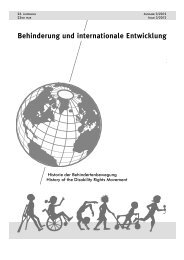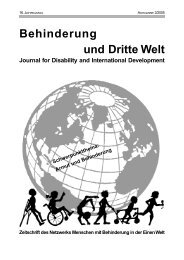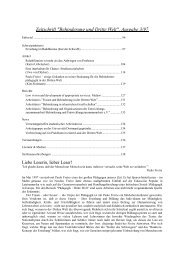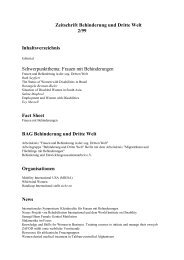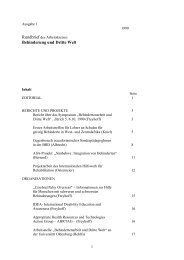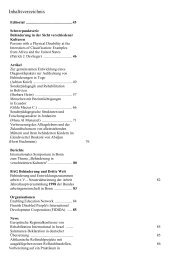Disaster and Disability in Bangladesh - Behinderung und Dritte Welt
Disaster and Disability in Bangladesh - Behinderung und Dritte Welt
Disaster and Disability in Bangladesh - Behinderung und Dritte Welt
Create successful ePaper yourself
Turn your PDF publications into a flip-book with our unique Google optimized e-Paper software.
A RTIKELthat relationships matter <strong>and</strong> are valuable <strong>in</strong>their own right <strong>and</strong> because they may lead toother benefits (social, economic <strong>and</strong>/or political).Despite the disagreement on the exactmean<strong>in</strong>g of the term, def<strong>in</strong>itions have not beenshortcom<strong>in</strong>g. The sociologist Pierre Bourdieu(1986: 248) def<strong>in</strong>ed social capital as “the aggregateof the actual or potential resourceswhich are l<strong>in</strong>ked to the possession of a durablenetwork of more or less <strong>in</strong>stitutionalized relationshipsof mutual acqua<strong>in</strong>tance or recognition”.In this case, the formation of social networksis not a natural process (hence requir<strong>in</strong>g<strong>in</strong>vestment <strong>in</strong> its own right through the formationof group relations), is not necessarilyharmless or egalitarian, but is <strong>in</strong>stead an attributeof well-positioned elites, utilised to ma<strong>in</strong>ta<strong>in</strong>their position <strong>and</strong>/or advance their <strong>in</strong>terests.In this case, social capital is <strong>in</strong>timatelybo<strong>und</strong> to power. Another contributor to theevolv<strong>in</strong>g social capital debate was Coleman(1994: 302) who def<strong>in</strong>ed social capital by itsfunction: “It is not a s<strong>in</strong>gle entity, but a varietyof different entities, hav<strong>in</strong>g two characteristics<strong>in</strong> common: they all consist of some aspect of asocial structure, <strong>and</strong> they facilitate certa<strong>in</strong> actionsfor <strong>in</strong>dividuals who are with<strong>in</strong> the structure.”The major impetus for the promotion ofsocial capital came from its most vociferousproponent, Robert Putnam (1993: 35), who describedsocial capital as the “features of socialorganisation, such as networks, norms, <strong>and</strong>trust that facilitate coord<strong>in</strong>ation <strong>and</strong> cooperationfor mutual benefit”. Social capital <strong>in</strong> thisview facilitates coord<strong>in</strong>ation <strong>and</strong> cooperationfor the mutual benefit of the members of theassociation, a process <strong>in</strong>volv<strong>in</strong>g largely horizontalsocial groups such as associations, clubs <strong>and</strong>voluntary agencies that br<strong>in</strong>g <strong>in</strong>dividuals togetherto pursue one or more objectives <strong>in</strong>which they have a common <strong>in</strong>terest (e.g. farmerorganisations). The World Bank draw<strong>in</strong>g on Putnam’swork, recently emerged as a major proponentof social capital, shift<strong>in</strong>g the attention ofthe concept towards the majority world, <strong>and</strong> oftenadopt<strong>in</strong>g a prescriptive stance <strong>in</strong> its applicationto poverty reduction. It def<strong>in</strong>es social capitalas “the <strong>in</strong>stitutions, relationships <strong>and</strong> normsthat shape the quality of a society’s social <strong>in</strong>teractions...Socialcapital is not just the sum of the<strong>in</strong>stitutions which <strong>und</strong>erp<strong>in</strong> society- it is the gluethat holds them together” (1999: 2).It is important to note that there are differenttypes of social capital <strong>and</strong> Woolcock (2001) dist<strong>in</strong>guishesbetween three. The first type, calledbond<strong>in</strong>g social capital refers to the ties betweenpeople <strong>in</strong> similar situations e.g. family members,close friends <strong>and</strong> neighbours. The second,bridg<strong>in</strong>g social capital refers to more distantconnections of people <strong>in</strong> similar situations, suchas friendships <strong>and</strong> work colleagues; while thethird type, known as l<strong>in</strong>k<strong>in</strong>g social capital refersto vertical relationships with those <strong>in</strong> positionsof power.In this paper, social capital is <strong>und</strong>erstood as“the norms <strong>and</strong> social relations embedded <strong>in</strong>the social structures of society that enable peopleto co-ord<strong>in</strong>ate action <strong>and</strong> to achieve desiredgoals” (Narayan 1999: 6). This def<strong>in</strong>itionusefully provides a broad conceptualisation ofsocial relations (hence <strong>in</strong>clud<strong>in</strong>g networks, associations,both formal <strong>and</strong> <strong>in</strong>formal <strong>and</strong> at micro,meso <strong>and</strong> macro levels), <strong>and</strong> the wordnorms allows a focus on the local context <strong>and</strong>relationships emerg<strong>in</strong>g from the gro<strong>und</strong>. Thisalso provides for more relative (as opposed toabsolute) <strong>und</strong>erst<strong>and</strong><strong>in</strong>gs aga<strong>in</strong>st which <strong>in</strong>dividualattitudes <strong>and</strong> behaviours are positioned <strong>and</strong><strong>und</strong>erstood. Therefore, it draws attention to thefact that contexts are multiple, varied <strong>and</strong> heterogeneous,<strong>and</strong> that consequently one needsto engage with the different socio-economic<strong>and</strong> cultural aspects, as opposed to generalis<strong>in</strong>gfrom one context to another.Social Capital - Insights <strong>and</strong>Contributions to the <strong>Disability</strong> <strong>and</strong>Development DebateThe major epistemological attraction of socialcapital <strong>in</strong> a development sector preoccupiedwith economic growth <strong>and</strong> numbers, h<strong>in</strong>ges ontwo factors: first of all, like the concept of socialexclusion, it is at least <strong>in</strong> theory relational; <strong>and</strong>the word capital implies that these social relationshipsare both valuable <strong>in</strong> their own right aswell as <strong>in</strong> enabl<strong>in</strong>g access to other benefits.These two perspectives are discussed below.Unprecedented Attention to SocialRelationshipsWhile other types of capital have long been acknowledged<strong>in</strong> development (human, natural,f<strong>in</strong>ancial <strong>and</strong> physical), what clearly emerges isthat these have <strong>in</strong>variably resided <strong>in</strong> <strong>and</strong> havebeen the exclusive property of the <strong>in</strong>dividual,<strong>and</strong> which are only a partial source of economicgrowth. As Portes (1998: 7) <strong>in</strong> fact notes:“...whereas economic capital is <strong>in</strong> people’sbank accounts <strong>and</strong> human capital is <strong>in</strong> theirheads, social capital <strong>in</strong>heres <strong>in</strong> the structure oftheir relationships. To possess social capital, aperson must be related to others, <strong>and</strong> it is theseothers, not himself, who are the actual sourceof his or her advantage.”Furthermore, social capital <strong>in</strong> the same ve<strong>in</strong>Zeitschrift Beh<strong>in</strong>derung <strong>und</strong> <strong>Dritte</strong> <strong>Welt</strong> 1/20105



